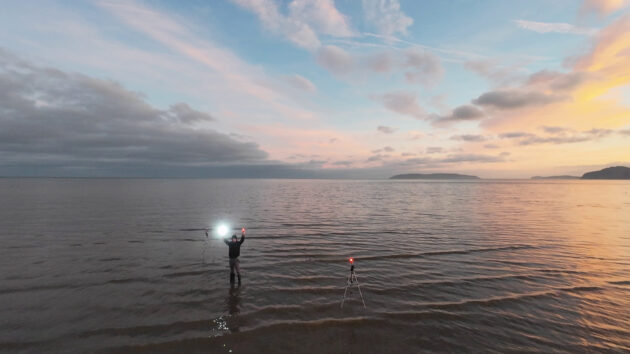Addressing the Limitations of Pyrotechnic Flares
For decades, handheld pyrotechnic flares have been an essential component of maritime distress signalling, alongside radios, EPIRBs, PLBs, and rocket flares. However, they present significant drawbacks:
- Limited burn time – Typically lasting under one minute, requiring multiple deployments for prolonged distress signalling.
- Unverifiable reliability – Flares cannot be tested before use, meaning their functionality is unknown until an emergency occurs.
- Safety risks – Burning at extremely high temperatures, they pose risks of severe burns and accidental fires.
- Disposal challenges – Classified as hazardous waste, expired flares require specialised disposal.
The Challenge: EVDS and Daylight Visibility
Electronic Visual Distress Signals (EVDS) have been introduced as a safer, more sustainable alternative to flares. However, current EVDS models do not meet the International Maritime Organization (IMO) light intensity requirements for distress signalling. The Maritime and Coastguard Agency (MCA) has stated that no EVDS currently meets the required brightness level of 15,000 candela to replace handheld red flares.
The primary issue with traditional EVDS is light intensity. Many models attempt to distribute LED-generated light in all directions (360° or across a hemisphere), reducing their effective brightness to approximately 100 Candela—suitable only for short-range visibility at night. Achieving sufficient brightness for daytime operation using this approach is impractical due to excessive energy demands.

Ultraflare Daylight: A New Standard in Visibility and Safety
Ultraflare Daylight was designed to overcome these challenges using a directional beam architecture, optimising visibility while conserving power. Key innovations include:
- Precision Beam Control – A 45-degree horizontal display ensures broad coverage, while a 15-degree vertical display enhances aerial visibility for SAR aircraft.
- Optimised LED Cluster Technology – Producing 15,000+ candela, making it 150 times brighter than standard EVDS and comparable to pyrotechnic flares.
- White Light for Maximum Visibility – White LEDs offer superior daytime visibility compared to red LEDs, using less power for greater range.
- Saltwater-Resistant Aircraft-Grade Aluminium Construction – Engineered for durability in extreme marine environments.
- Pre-Deployment Testing Capability – Unlike flares, Ultraflare Daylight can be functionally tested before an emergency, ensuring operational readiness.

Empirical Testing: Real-World Performance Validation
- Ultraflare Daylight was extensively tested in the day against pyrotechnic flares, orange smoke signals, and conventional EVDS models to validate its effectiveness in real-world scenarios.
- EVDS Comparison – Traditional EVDS devices were barely visible beyond very close range (200m), while Ultraflare Daylight remained highly visible beyond 3 nautical miles.
- Smoke Signal Comparison – Orange smoke signals dissipated rapidly in 20-knot winds, while Ultraflare Daylight provided a stable and continuous distress signal.
- Search & Rescue Recognition – A commercial pilot with SAR experience confirmed from a search aircraft that Ultraflare Daylight was clearly visible beyond 3 nautical miles, exceeding necessary visibility thresholds.
- Pyrotechnic Flare Safety Assessment – During testing, traditional flares burned through protective gloves and caused an accidental fire, whereas Ultraflare Daylight provided comparable brightness without these hazards.

Regulatory Landscape & Future Adoption
The Royal Yachting Association (RYA) has recognised EVDS as a valuable tool for final-mile locating but notes that current regulations still favour pyrotechnic flares. The MCA states:
“It is not aware of any EVDS product which meets the light intensity required by the IMO for distress flares. This means that if your commercial vessel is required to carry flares, they cannot be an EVDS product. . . Where carriage of flares is not mandatory, the MCA nevertheless advises that EVDS should not currently be carried as a substitute for conventional pyrotechnic flares . . . However, for pleasure vessels, seagoing commercial vessels, and most non-seagoing commercial vessels, EVDS may be carried in addition to the required distress signalling equipment and used to identify location or transmit the S-O-S distress signal.”
Given that Ultraflare Daylight meets the necessary light intensity requirements, it stands to reason that it could be accepted as part of evolving regulations.
For pleasure vessels under 13.7m, Ultraflare Daylight is a practical day and night alternative to red hand flares and orange smoke signals, aligning with RYA guidance on distress signalling. It is also highly suitable for kayakers, paddleboarders, and PWC users who require a compact, powerful, and long-lasting distress signal.
For larger vessels (13.7m+) and commercial operators, traditional flares remain mandatory. However, as the industry moves towards safer and more sustainable alternatives, non-pyrotechnic solutions like Ultraflare Daylight are likely to gain regulatory recognition in the near future.

The Future of Marine Safety
- UK and European Outlook – It is anticipated that regulatory bodies will reassess EVDS classification, with Ultraflare Daylight positioned as a credible replacement for handheld red flares and orange smokes.
- U.S. Approval Process – The USCG is expected to approve Ultraflare for night-time use under existing regulations, with adjustments for full daytime approval likely.
- Global Maritime Safety Evolution – Over the next five years, discussions at the IMO are expected to explore the integration of high-intensity EVDS as an alternative to handheld pyrotechnic signals and smokes.
Upgrade to Ultraflare Daylight Today
Make sure your vessel is prepared for the future of marine distress signalling. Learn more at www.ultraflare-daylight.com.




